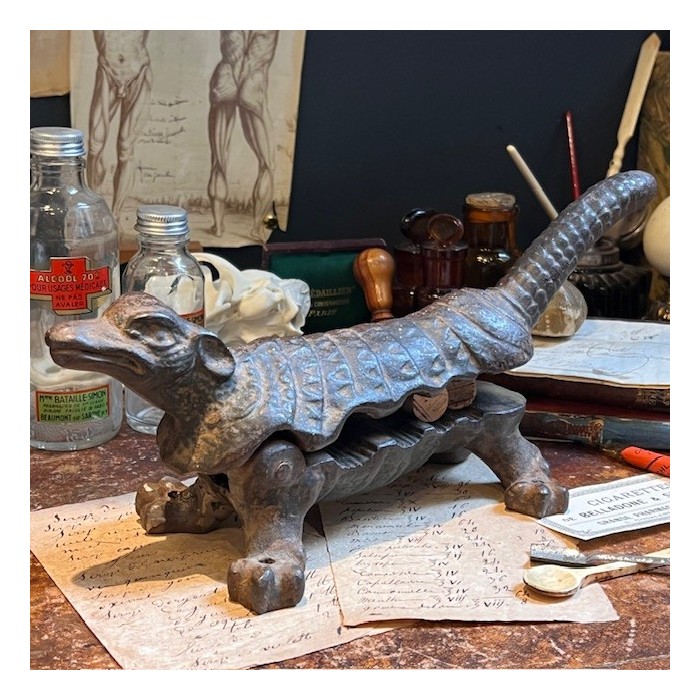- New
























Pharmacy corkscrew in the shape of an armadillo, an unusual and sought-after design
19th-century cast iron
One prong has been repaired and re-welded
Pharmacy cork crusher in the shape of an armadillo, an unusual and sought-after design
19th-century cast iron
The cork crusher was invented around 1830 and was used throughout the 19th century until the early 20th century. It allowed pharmacists to compress and soften corks before inserting them into bottles containing medicine.
They were often fixed to the counter in apothecaries' or pharmacists' shops by screwing them in place, like this one with holes in its legs.
Cork crushers are very often found in zoomorphic form, particularly in the shape of a crocodile, which is also the other name for a cork crusher, but here the less common but much more sought-after shape of an armadillo has been chosen.
Old weld on the front right leg
Length: 28 cm
It weighs 2.6 kg!
Before these objects appear, the apothecary or the pharmacist chewed himself the corks to insert them in the bottles... From where the term chewing-cork...
The human body - Anatomy of Man
Removable anatomical board
circa 1900 by VIGOT Frères éditeurs
Colored loose-leaf board, cut out and superimposed
Some traces of adhesive on certain organs such as the liver, for example, but not much
Hypophosphite de Manganèse
Antique pharmacy bottle
Apothecary vial
Lower part of the lower mandible of a horse jaw
Antique model from Maison Auzoux in Paris
Paper-mâché pedagogical model
Model A - 9 months
Menthol
Antique pharmacy bottle - Apothecary
There is still a little product left inside
Quinine Extract Pills
Antique pharmacy bottle - Apothecary
There is still some product left inside
An antique absinthe topette (decanter)
6 Beaded Topette
Residue in the bottom of the carafe
Antique glass dropper in white glass
Apothecary - Pharmacy
Heart-shaped stopper
Chlorure Zinc
Antique white glass pharmacy bottle - Content: 30ml
Apothecary - Pharmacy
Two chips on the neck: see photos - The cap is blocked
L'art de procréer les sexes à volonté - The art of procreating sexes at will
By Millot - With illustrated plates
Antique book from 1802 (Year X of the Republic) - Third edition
The author explains how to procreate boys and girls, and gives his recipes for treating sterility and malformations...
Antique drum microscope
With its wooden case containing 1 brass clamp
XIXth century
The microscope is engraved on the eyepiece Manufacture Française Armes et Cycles Saint-Etienne
Antique drum microscope for botanist, entomologist
Mirror missing
Late 19th century, early 20th century
Antique brown glass bottle with integrated pipette - Ref B
Apothecary - Pharmacy
The pipettes have either been broken or shortened because they are too short
Antique drum microscope
In it's mahogany wooden box
For botanist, entomologist
Ref A
Antique box of scalpels - Surgery from Collin Manufacturer
Late 19th/early 20th century
11 instruments
Antique study mask by Simonne Laubé, circa 1930
Flayed model
In vulcanized and painted rubber
Inspired by the famous death mask from L'Inconnue de la Seine

Pharmacy corkscrew in the shape of an armadillo, an unusual and sought-after design
19th-century cast iron
One prong has been repaired and re-welded






















